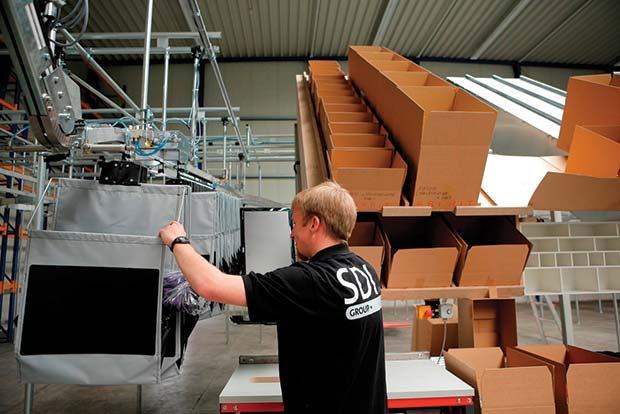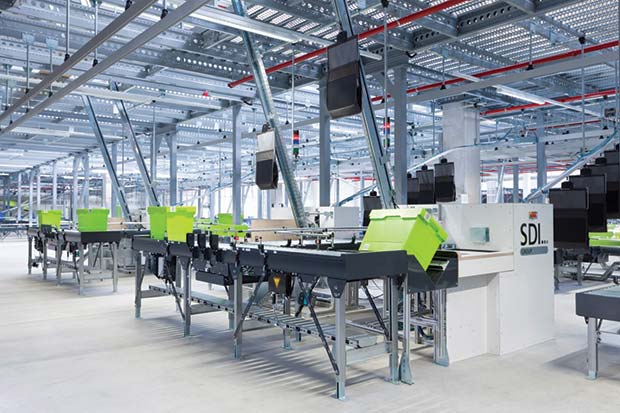Multichannel fashion retailers are fast realising that the processes that surround fulfilment are critical to winning sales, retaining customers and growing margin. But there are challenges, issues such as: How do you efficiently pick hanging garments and consolidate them with flat goods for a single order? How do you push ‘cut-off’ to the latest possible time? And, can the legwork be taken out of getting returned goods re-sold and despatched?

Winnie Ahrens, Sales Manager SDI Group Europe, describes a startling innovation set to transform the way leading fashion retailers organise their fulfilment operations. Large fashion brands in the UK and Germany are presently installing a highly flexible hanging pouch sortation and buffering system, developed by SDI Group under the name ‘MonaLisa’; rationalising the sortation of both hanging items and flat goods, bringing huge productivity gains over conventional automated solutions.
What are the challenges faced by multi-channel retailers in assembling orders for e-fulfilment? And how can sortation technology meet those challenges?
“If you say, order 3 or 4 items from an online fashion retailer, then you might have a dress that is stored in a hanging condition, and you might have other things like shoes or a shirt that are in a static storage position, and these items have to be consolidated in one order to be shipped for delivery. So how do you do this efficiently?
“The fast growth of the ecomm market became the driver for us to develop a solution that brings these two types of items, hanging and flat goods, together – it is the next generation of automation for direct to consumer operations. The MonaLisa adapter and pouch system allows hanging and flat garments to be transported together in an overhead conveyor system, storing items in dynamic picking loops which enables them to be accessed rapidly whenever an order is called off by the warehouse management system for the packing stations.”
“But ecommerce retailers also have another problem. They are suffering from a high rate of returns – return rates up to 50% in Germany. That means they struggle to put goods back quickly into storage so that they can be resold and available for picking again. However, the MonaLisa system offers a solution to this big problem.”
What makes the MonaLisa a creative leap forward in managing returns? Why is it any better than the usual approach of just returning goods to shelves and then picking them when the next order comes in?
“With the Monalisa system, instead of putting returned goods away onto the shelves again, which is a manual, labour intensive process, the operator just puts a returned flat item into a pouch or attach a hanging item to it on the outside and we store and buffer it automatically in a dynamic buffer area where we can pull off any item when it has been ordered again by someone else.
“In essence, what we hear from ecommerce companies is that they are reselling about 90% of returned merchandise within three days. So this automated buffering system saves a tremendous amount of labour for put away and re-picking, making a big difference in efficiency for an ecommerce fashion retailer.

It’s common for people to order clothing in two or three sizes, keep the one that fits and then return the others. Will this solution help retailers with this big problem?
“It certainly will – by taking the legwork out of returning goods to the shelves.
“In a traditional operation, you walk through the aisles in a static storage and put items away into their right storage locations manually. Only then items are available for picking. Re-picking these items would be done by a separate person so it is very labour intensive.
“This was the driver for this whole innovation – the development of MonaLisa.”
“At the same time as you are taking in returned items, you will probably receive a new order for the same item. Retailers often have special offers, so in that promotional period you can be certain that an item will be ordered several times a day. So placing returned items into a pouch and sending them off into a dynamic storage and buffering system, you can immediately recall it to fulfil the new order. The process of making returned goods available for sale again is very fast – efficiency is very high – and you greatly reduce the amount of time, effort and labour required.
What sort speeds are we talking about? How many items per hour can be handled and sorted?
“We have designed the MonaLisa system in a modular way. Each module can sort up to 7.500 items/h. If a customer has a requirement for a sorting capacity of more than that, we would add a second sort module. The actual transfer areas can go as fast as 12,000 items per hour, but sortation is lower because there is dead-time for reloading and clearing the sorter areas, so the 7,500 is a safe figure
Is it expensive to install?
“Price wise it is comparable with any fully automated single hanging garment system. If you compare it with a shuttle or miniload system – often used for this type of operation – it’s probably cheaper. It’s lighter and uses less energy, because its friction driven.
“One German fashion retailer with a strong ecommerce operation, which is commissioning MonaLisa right now, has one conveyor that crosses various areas and is more than 600m long. It is one enclosed conveyor and we just add additional drives to it – so it’s very, very efficient. And we have a second system underway in the UK.”
What are the key technical advantages of the MonaLisa solution over other systems?
“One major thing is the friction driven conveyors. Also we are not using common metal chains, we are using plastic moulded linked wheel sets, which roll within an aluminium profile. This is far superior to the traditional metal chains used in hanging goods systems – such chains generate a lot of friction, creating ware and absorbing a lot of energy. These systems are limited to a conveyor length of approx. 30 – 40m in length and then they have to start a new drive and a new chain, and you have a have a join between two conveyors. With our technology, the friction driven plastic chain is propelled forward by rollers, with far less friction, reducing energy consumption and enabling much longer conveyor runs.”
“Of course, an important aspect of the MonaLisa is that it’s an overhead system which maximises the use of space above the floor, and you can build it in silos so you have various levels of dynamic buffering inside a high density storage area.”
Phone: 01763 244299
Email: info.uk@sdigroup.com
Web: www.sdigroup.com
Twitter: @SDIGroupLtd
Facebook: SDIGroupUK
LinkedIn: sdi-group-ltd





Comments are closed.